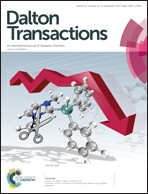Retrosynthetic approach to the design of molybdenum–magnesium oxoalkoxides†
Abstract
The reaction of MoCl5 methanolysis in the presence of magnesium ions was shown to produce an extensive row of heterobimetallic Mg–Mo(V, VI) oxomethoxides of different nuclearity ranging from 4 for [Mg2(CH3OH)4Mo2O2(OCH3)10] (1) to 26 for [Mg(DMF)3(CH3OH)3]2[Mo22Mg4O48(OCH3)28(DMF)6] (2) with the latter possessing a ring morphology. Examination of [Mo6O12(OCH3)16Mg4(CH3OH)6] (3), [Mo6O12(OCH3)12Mg2(DMF)4] (4a), and [Mo6O16(OCH3)4Mg2(DMF)8] (5a) X-ray structures revealed the presence of the well known tetranuclear core {Mo4O8(OCH3)2}2+ thus similar reactivity patterns leading to their formation were assumed. For convenient synthesis of such heterobimetallic oxoalkoxides, the retrosynthetic approach based on speculative deconstruction of a target molecule onto simpler fragments was suggested and successfully employed. Namely, the reaction of the stoichiometric amounts of appropriately chosen Mo(V), Mo(VI) and Mg2+ synthons led to their assembling resulting in the formation of heterometallic clusters 3, 5a and [Mo6O12(OCH3)12Mg2(CH3OH)4]·2CH3OH (4b) characterized by means of elemental analysis, UV-Vis, IR spectroscopy, and X-ray crystallography.


 Please wait while we load your content...
Please wait while we load your content...